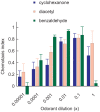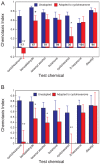Behavioural and genetic evidence for C. elegans' ability to detect volatile chemicals associated with explosives
- PMID: 20830309
- PMCID: PMC2935383
- DOI: 10.1371/journal.pone.0012615
Behavioural and genetic evidence for C. elegans' ability to detect volatile chemicals associated with explosives
Abstract
Background: Automated standoff detection and classification of explosives based on their characteristic vapours would be highly desirable. Biologically derived odorant receptors have potential as the explosive recognition element in novel biosensors. Caenorhabditis elegans' genome contains over 1,000 uncharacterised candidate chemosensory receptors. It was not known whether any of these respond to volatile chemicals derived from or associated with explosives.
Methodology/principal findings: We assayed C. elegans for chemotactic responses to chemical vapours of explosives and compounds associated with explosives. C. elegans failed to respond to many of the explosive materials themselves but showed strong chemotaxis with a number of compounds associated with commercial or homemade explosives. Genetic mutant strains were used to identify the likely neuronal location of a putative receptor responding to cyclohexanone, which is a contaminant of some compounded explosives, and to identify the specific transduction pathway involved. Upper limits on the sensitivity of the nematode were calculated. A sensory adaptation protocol was used to estimate the receptive range of the receptor.
Conclusions/significance: The results suggest that C. elegans may be a convenient source of highly sensitive, narrowly tuned receptors to detect a range of explosive-associated volatiles.
Conflict of interest statement
Figures




References
-
- Gardner JW. Review of conventional electronic noses and their possible application to the detection of explosives. In: Gardner JW, Yinon J, editors. Electronic Noses and Sensors for the Detection of Explosives. Dordrecht, The Netherlands: Kluwer Academic Publishers; 2004. pp. 1–28.
-
- National Research Council (U.S.) Science and technology for Army homeland security : report 1. xxi, 161. Washington, DC: National Academies Press.; 2003. Committee on Army Science and Technology for Homeland Defense.
-
- Williams M, Johnston JM, Cicoria M, Paletz E, Waggoner LP, et al. DePersia AT, Pennella JJ, editors. Canine detection odor signatures for explosives. SPIE. 1998. pp. 291–301.
-
- Williams M, Johnston JM. Training and maintaining the performance of dogs (Canis familiaris) on an increasing number of odor discriminations in a controlled setting. Appl Anim Behav Sci. 2002;78:55–65.
-
- Harper RJ, Almirall JR, Furton KG. Identification of dominant odor chemicals emanating from explosives for use in developing optimal training aid combinations and mimics for canine detection. Talanta. 2005;67:313–327. - PubMed
Publication types
MeSH terms
Substances
LinkOut - more resources
Full Text Sources
Other Literature Sources

